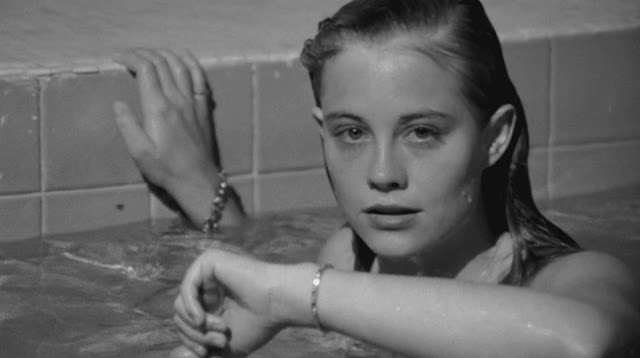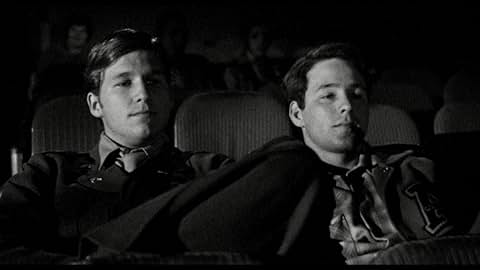Change is inevitable. There is always a percentage of the population, though, that resists change and resents that things cannot remain the way it always has been, or at least the way it seems to always have been. Three days before I loaded up my copy of The Last Picture Show my son sent me a link to a news article that informed me that because of raising wages and taxes in Washington state the local movie theater, the only one in town, was closing down for good in about two weeks. This theater had been a consistent place for me to watch new releases every week and with it closing I would now have to drive over twenty miles out of town to get to the next closest theater. The reasons given seem perfectly legitimate but I suspect the advent of streaming services coupled with the significant decrease in time between theatrical and digital releases and the rise of home theaters that rival local theaters have helped this closure along. This is especially difficult for families who look at spending $80 or more just to take the family out to the movies and can wait a couple of months to see the latest movies on a streaming platform for a fraction of that price. While I understand why the theater is closing I am resistant to it happening as I have always looked forward to the theatrical experience, something that cannot be replicated at home even with my projector and Atmos surround system. Seeing a film with a large and enthusiastic crowd will always trump what I can do at home.
This upcoming change to my life was forefront on my mind as I started watching The Last Picture Show, knowing what the film was all about. The themes of small town America as everyone is graduating, marrying, dying, or moving away are particularly poignant to me now much more than it was when I first saw this film. Peter Bogdanovich, working off a novel by Larry McMurtry, has crafted a classic film about these heavy themes that nearly everyone must confront at some point in their lives. Technology changes, interests shift, people grow old, get sick, or die suddenly without warning. Girlfriends or boyfriends come and go and those whom we thought would be a major part of our lives are suddenly absent from it. I girl I once thought would be the love of my life moved thousands of miles away and I lost track of her until a few years ago thanks to the advent of Facebook. She died recently and even though I hadn’t seen her in nearly thirty years I was still devastated by that news. I was no longer in love with her and hadn’t been for decades but the pain of her death still cut me to the core. Things change but things also sometimes stay the same, too.
Watching The Last Picture Show has made me feel introspective a little. The story is not all that impressive when distilled down to the actions of the characters but when examined as a whole there is an awful lot to process and digest. It focuses on the small town of Anarene, an oil town in Texas. Sonny Crawford (Timothy Bottoms) and Duane Jackson (Jeff Bridges) are high school seniors and best friends. Duane is dating rich girl Jacy (Cybill Shepherd) but their relationship has stagnated. Sonny is secretly in love with her but doesn’t act on it out of respect for his friend. At a Christmas party Jacy is invited to a skinny dipping party at the home of Bobby Sheen (Gary Brockette), a wealthy young man that her mother, Lois (Ellen Burstyn), considers to be a better prospect for her daughter. At the party Bobby makes an advance on her but, although she is willing, he backs off when he hears that she is still a virgin. She will try to change that status with Duane but finds that when the time comes he is incapable of performing.
Meanwhile Sonny has begun having an affair with Ruth (Cloris Leachman), the wife of one of his teachers. She is in a loveless marriage and, unable to drive, rarely leaves their home. When Sonny is hired to drive her around it begins a relationship that eventually becomes physical. When Jacy breaks up with Duane and shows interest in Sonny he leaves Ruth and starts seeing Jacy instead, further damaging her fragile self worth. Duane, graduated from high school, discovers that life has moved on without him as his exploits on the football field have been eclipsed by the next generation of rising athletes and he’s only remembered as someone who no longer plays for the team. He enlists in the army and will soon ship out to Korea. Before he leaves, though, he confronts Sonny about Jacy which leads to him assaulting his friend, leaving him hospitalized with the side of his head and one eye bandaged up. Eventually they will make amends, attending the last showing at a local theater which is closing down from a lack of customers. It’s not outright said but the understanding is that television has usurped the viewers in town enough to cause this business to shut down. Progress, right?
If the time period were a little more focused this could be considered a slice-of-life film. It’s a portrait of a small town during a time when so much was changing. Peter Bogdanovich elected to film it entirely in black-and-white to evoke that time period as well as on a suggestion from his friend Orson Wells who insisted the format improved the actors’ and actresses’ performances. While he was initially skeptical about this, when he saw the final results he couldn’t disagree. Neither can I. There is a reason I am drawn to black and white films. Something about that monochrome look just has an appeal you don’t get from a film in color. Several modern directors even release their new films in both color and black-and-white to appeal to audiences that like that old-style look in their modern films.
Many actors and actresses were first introduced to audiences in this film. Jeff Bridges, son of film legend Lloyd Bridges, had appeared in a couple of no-budget pictures the previous year so for many this was their introduction to him. Cybill Shepherd was a model that Peter Bogdonovich saw on the cover of a magazine. He instantly knew he wanted to cast her in his next picture. This would be the beginning of a love affair between the two that lasted for eight years. She was initially reluctant to appear nude in the film but was reassured by the director and quickly got comfortable with her infamous scenes skinny dipping in a private indoor pool. Timothy Bottoms was also new to the scene with just a single film earlier that year. This was just the type of film to highlight new talent and propel them into solid careers in their futures.
The Last Picture Show was not without its fair share of controversy. Any film that takes a frank look at sexuality will face protests and disdain, especially in that era. The film was nearly banned in some states for being “lewd.” This was especially the case in areas where it showed on drive-in screens where anyone with a pair of binoculars could reasonably get a good view of Cybill Shepherd in the buff. It’s just the kind of controversy that would lead to more people seeking the film out than it would dissuade them from seeing it. When you try to ban a film or censor it all it accomplishes is getting more people interested in seeing it in all its glory. The skinny dipping scene is arguably important to the overall story as it paints a picture of who Jacy is. She is quick to participate, stripping naked on the diving board in front of a large group of men and women. She hesitates for a moment but she does do it. Once she’s in the water she notices she is still wearing the fancy watch Duane just gave her earlier that day. It is ruined from being in the pool but she really doesn’t care.
If The Last Picture Show is about anything it is about endings. Friendships and lovers end. Virginity ends. Even life ends. The film itself ends with the life of one of the main players ending. Billy (Sam Bottoms), a simple young man, is hit by a truck and killed while sweeping the street. Duane and Sonny end their friendship over Jacy. They will make amends in a theater showing its final film but Duane is off to Korea and may not come back. Even if he does this is an ending of sorts for him, too, as he will not be the same man when he does come back. A sequel, Texasville, came out nearly twenty years later and attempts to answer some of those questions to mostly poor reviews. It’s the sequel no one asked for and no one really needed. The Last Picture Show ends on the perfect note and didn’t need a followup. It’s a slow story but it’s never dull. For a small town boy like me there was a lot I could relate to. It’s not the kind of movie I’ll revisit often but when I do I always enjoy the ride.
Academy Award Nominations:
Best Picture: Stephen J. Friedman
Best Director: Peter Bogdanovich
Best Supporting Actor: Jeff Bridges
Best Supporting Actor: Ben Johnson (won)
Best Supporting Actress: Ellen Burstyn
Best Supporting Actress: Cloris Leachman (won)
Best Screenplay - Based on Material from Another Medium: Larry McMurtry and Peter Bogdanovich
Best Cinematography: Robert Surtees
____________________________________________________
Release Date: October 22, 1971
Running Time: 118 Minutes
Rated R
Starring: Timothy Bottoms, Jeff Bridges, Ellen Burstyn, Ben Johnson, Cloris Leachman and Cybill Shepherd
Directed By: Peter Bogdanovich









Comments
Post a Comment